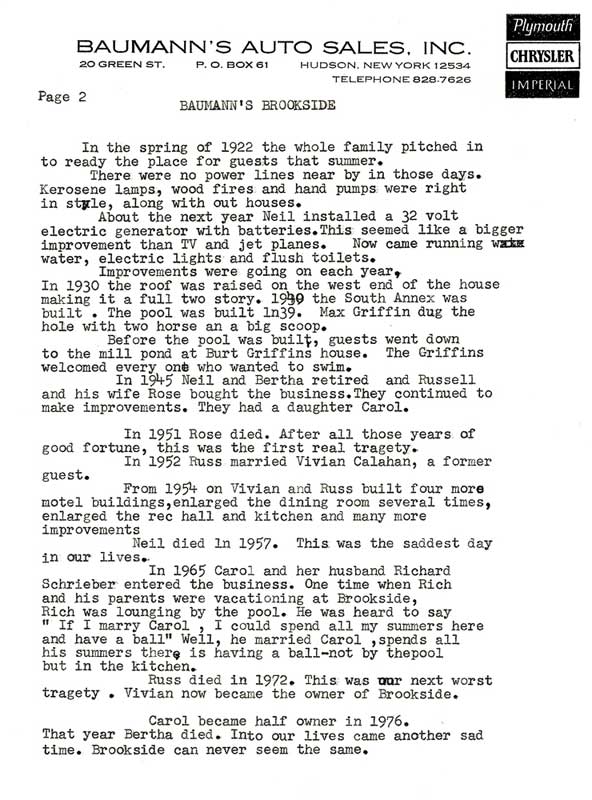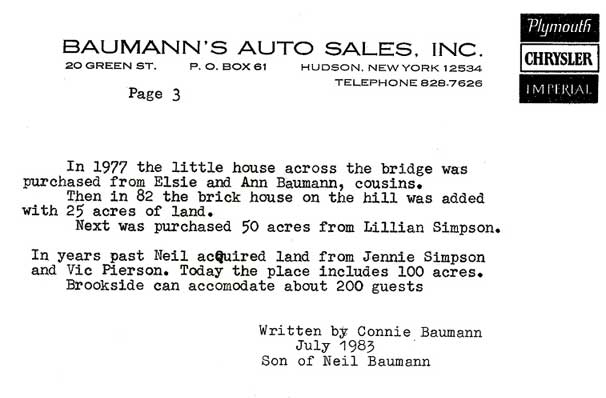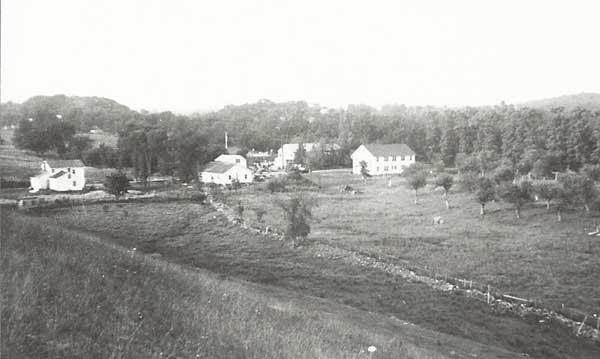A warm, low-80’s Monday-before-Memorial-Day awaited the attendees of the May meeting. Among the regulars: Walter & Donna Ingalls, Bette Welter, Evelyn Jennings, Mary Heisinger (now a regular!), Christine Mickelsen, Bob & Marie Shaw, Stephanie Ingalls, Phyllis Beechert, and Don Teator. Add in the almost regulars, the newcomers, the hosts, and we totaled in the 30-35 range—a nice turnout indeed.
The draw of the evening was both the setting and the topic of the evening—Baumann’s Brookside, one of the three long-running original boarding houses that still survive and remain strong in 2013. We used Baumann’s to show the historical cycle of boarding house/resort in Greenville.
So, before I get into the meat of the topic, allow me to thank Carol and Rich Schreiber for not only hosting our group but also providing refreshments. Another treat this evening was the participation of the other families—Roe & Kevin Lewis and sons Tucker and Russell, Courtney Reinhard, and Joan Smith. More about importance of family later.
Upon entering the dining room through the lobby, one found several tables laden with photos of the resort throughout the years. Brochures of past years were shown, as were brochures of other nearby resorts. Also shown was a sketch of the resort by one Fred Becker, of unknown identity to us from the 1930s.
After my brief introduction, Carol took the reins and ran with the
show until the question period. I will write some of the snippets I
remember or made notes of.
Actually, on second thought, I will copy the short history that Con
wrote and gave me more than a few years ago, and I will fill in a couple
pieces. So, if you want, take time to read that now. (see below)
house (described in Con’s notes) near Place’s
Corners (the intersection of Sunny Hill, CR 41, and Drake Hill Rd), if my
directions are right, is north of the corners on Rt 41, up and past the
first couple houses on the left. The driveway is on the right, washed out
after a couple big storms in the past ten years.
My other sense, as Carol was talking, was three stages of building.
One came at the beginning, in the 1920s, when they needed to establish the
Johnny Cake Lane venture. The second big stage came around 1940, followed
by the third stage in the late 1950s and early-mid-1960s.
Carol noted that early entertainment was self-made—swimming in
the mill pond (yup, the Red Mill dam pond), walking the roads and fields,
and so on. Fresh air and getting away from the city was reward enough. Of
course, guest expectations of what is entertainment world change
constantly.
And Carol told a story or two of personal nature that is not part
of the official history of Baumann’s but is so typical of families
working together and dealing with stressful times. (The only clue I will
reveal is “Prohibition.”)
Carol noted the effect of deaths in the family, her own mother
passing away and how her step-mother Vivian became and remained a strong
force in her (Carol) life.
At some point, Carol asked each of the family members
to say something, and to their credit, most did, and presented the human
face of a family-owned business.
And that influence of family is an important element in the three
remaining resorts—the succeeding generation picks up to continue the
business. Without that, and without that happening at the right time, the
decision to withdraw from the resort business is often made (if other
factors have not already forced the issue)..
We debated the correct pronunciation: bough-men over
bo-men (emphasis on the bough of the tree, not the bo of Little Bo Peep).
Richard Nestlen, who I had never met before, introduced himself as
the delivery man of chlorine products to the area resorts. Anyone
associated with the resorts in the 1960s on may remember Spick products (a
name that would not do today!) and Richard was still delivering locally
into the 1980s.
Carol talked about some of the challenges of the modern era, the
next five or ten years, and this provoked some commentary from the floor
about successes, or otherwise, of area businesses that have since become
part of PAST history. (Shepard’s was a main topic, and such a visible
one today.)
The meeting closed, we scouted out more photos, and chatted some
more before leaving. We had witnessed what I affectionately call real
local history, a meeting that measures up to my standard of superb,
if you can excuse my enjoyment and pride in local history, knowing that
many in the audience this evening share it as strongly as I do.
We had started the meeting with introductory material
– GLHG history, sign-up sheet, email newsletter, etc.
Mary Heisinger updated the audience about the Memorial Day
festivities, and about upcoming CWRT events (book discussion on June 12).
Contact Mary if you might be interested in the Civil War activities. (The
Memorial Day program, despite record low daytime temperatures and a
consistent light rain, did Greenville proud. Great job, Mary, in
organizing the day!)
Mary Lou Nahas noted her boarding house efforts. Although she
blames/credits me for her start, she and Nick have certainly pulled
together a fine collection of pictures of resorts in the Town of Durham.
Most of this is on Facebook (type in Boarding House, Hotels, and Resorts
in Durham NY) and you will see the public back-and-forth in helping Mary
Lou find even more!
Our next meeting, on June 10, should be another worthy meeting. I have employed the services of Chuck D’Imperio to be our guest feature. To quote from my press release;
… Chuck D’Imperio, a lover and story-teller of things Upstate New York. Chuck is a radio broadcaster at WDOS in Oneonta (NYS’ Broadcaster of the Year, 2000), a newspaper columnist, an inductee into the NYS Country Music Hall of Fame, a speaker at over 40 sites a year, and father of four children.
His works include: Monumental New York: A Guide to 30 Iconic Memorials in Upstate New York; Upstate New York in 100 Words or Less; Great Graves of Upstate New York; Upstate New York: History Happened Here; and soon-to-appear 50 Museums in Upstate New York You Have Never Heard Of.
Chuck’s style is to capture the big picture by drawing attention to the lesser known; the out-of-way; the quirky; and to people, places and events that deserve attention. With his engaging speaking style, D’Imperio will inspire you to read more and to look at our surroundings in a different delight. His books will be available this evening to be signed.
I first listened to Chuck at a Gilboa Historical Society, and based on how little, or nothing, I had ever heard about Chuck locally, I thought he would be an interesting and worthwhile reason for a night out, both for people who love local history as well as for people who enjoy listening to stories of the small pieces of history of upstate New York.
A sad note: Dot Blenis, one of our mainstays for stories and notes of longer ago than most of us could tell, passed away this past month. She certainly lived a full and active long life.
Included below are a couple of pictures of Baumann’s.
C’mon out to the June 10 meeting, and bring a friend who wants to be entertained by a versatile story-teller.
Take care,
Don




Baumann's -- early-mid century

view from hill southwest of resort, main house behind trees at center of photo, at junction of Johnny Cake Lane and Red Mill Rd